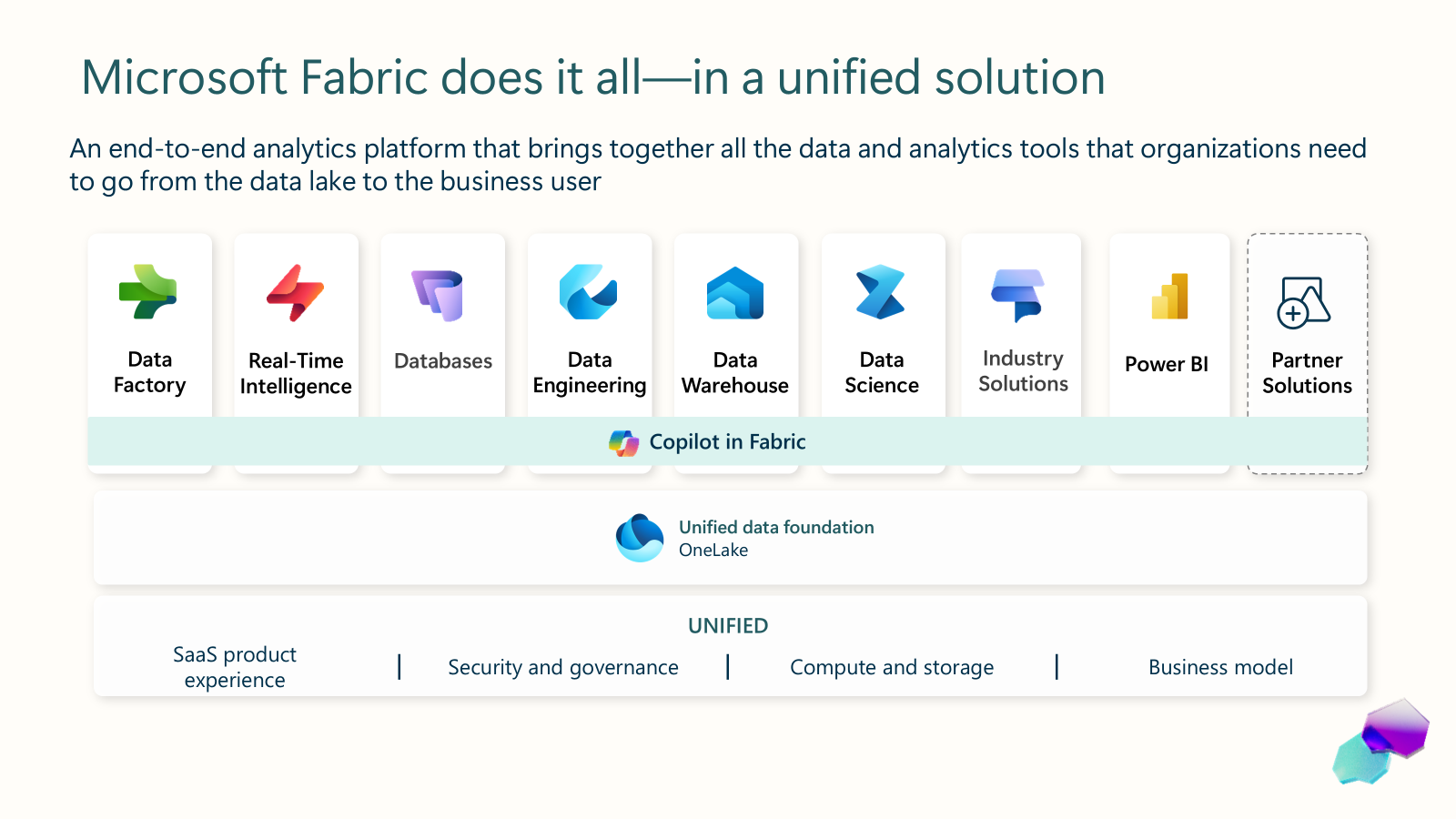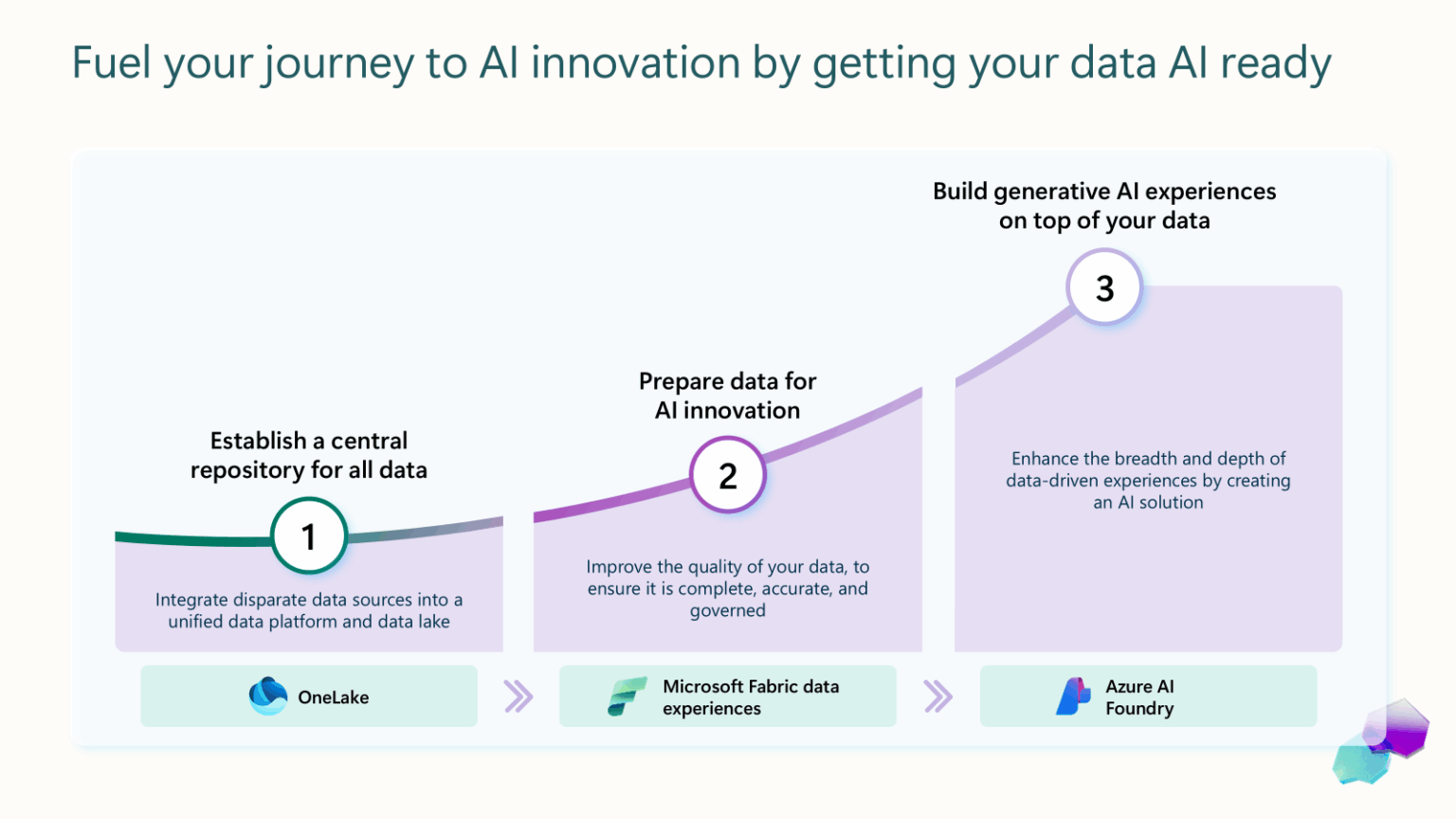Until recently, connecting large AI models to enterprise-scale data meant splitting or summarizing datasets due to LLM token limits, requiring heavy engineering and brittle frameworks. Tools like LangChain offered a path forward but often demanded deep technical skill. Real AI-driven business insights remain inaccessible for many organizations.
That barrier is disappearing.
While tools like LangChain still play an important role, Microsoft Fabric Data Agents offer a simpler, more secure alternative for organizations using Microsoft’s ecosystem which dramatically reduces hybrid integration complexity and enables conversational data access across large, diverse datasets.
What is a Fabric Data Agent?
Fabric Data Agents are conversational Q&A systems that make data insights accessible to your organization. They serve as intelligent orchestrators between user questions and business data, processing natural language queries and returning human-readable responses with no SQL expertise required.
How They Work: Using Azure OpenAI Assistant APIs, agents process user questions while maintaining security protocols and existing permissions. They identify the most relevant data sources across your environment, automatically generate the appropriate queries (SQL, DAX, or KQL), validate for security compliance, and format results for immediate use. Data Agents are currently best suited for developers and business analysts. That said, tools like Copilot Studio and Azure AI Foundry make it relatively straightforward to build a Copilot for Microsoft 365, Teams, or even embed one in an existing application that connects to a Data Agent in the background. Microsoft also appears to be working toward a more accessible experience for business users, with the goal of enabling question-and-answer interactions with Data Agents without requiring access to the Fabric admin portal.
The Connectivity Advantage: Unlike previous solutions that required extensive custom integrations, Fabric Data Agents connect to 4 data sources today, all native artifacts in Fabric: Lakehouse, Warehouse, KQL database, and Power BI semantic model.
Recent improvements have expanded Fabric’s ability to handle large datasets, including environments with thousands of tables and high-column-count models. While Fabric Data Agents still operate on native Fabric artifacts, external systems like Oracle, SAP, and Postgres can be brought into Fabric and queried once ingested.
This represents a fundamental shift in Microsoft’s platform strategy, moving from ecosystem exclusivity to hybrid reality integration where your data lives.
Current Capabilities and Limitations: Microsoft Fabric Data Agents are currently in preview, with Microsoft continuously expanding their capabilities. Current agents generate SQL/DAX/KQL ‘read’ queries and work with structured data sources within Fabric. Note that they do not currently support unstructured data (.pdf, .docx, or .txt files). However, solutions built with Copilot Studio or Azure AI Foundry can bridge this gap by enabling agents to access unstructured data while also calling Data Agents for structured sources.
How Organizations Are Using Fabric Data Agents
Sentiment Analysis at Enterprise Scale
The Challenge: A global bank manages facilities across 200+ office buildings, generating structured survey responses about employee satisfaction. Without automation, surfacing trends by region or building was time-consuming and inconsistent.
The Solution: After ingesting structured survey results into Fabric’s native sources (like a Lakehouse or Warehouse), Fabric Data Agents allow users to query insights using natural language. For example, “What are the top-reported issues in Building A?” or “Which regions reported the highest dissatisfaction last quarter?”
The Value: Managers gain hyperlocal insights to address issues faster, while executives spot cross-location trends, leading to more proactive facilities management and improved tenant satisfaction.
Conversational Access to Secure Business Systems
The Challenge: We frequently encounter customers asking about ChatGPT versus Microsoft Copilot, particularly when IT teams prefer ChatGPT’s personalized experience. The critical question is which ChatGPT is the customer using? ChatGPT does offer paid enterprise versions that include data privacy features, although it won’t offer in-app experiences, Microsoft Graph integration, or other differentiating Copilot features. If a customer is allowing users to use the consumer version of ChatGPT then the critical distinction is data security: consumer ChatGPT makes corporate information accessible to OpenAI, while Fabric Data Agents and Microsoft Copilot keep data secure within your corporate environment.
The Solution: This security advantage enables conversational access to structured organizational data, as long as it has been ingested into the Fabric environment. For example, employees can ask, ‘What is my benefits package?’ and receive a response based on structured HR data ingested from systems like PeopleSoft or modeled within Fabric’s native data sources.
The Value: Self-service employee support that reduces help desk tickets while ensuring data governance and compliance requirements remain intact.
Fabric Data Agents and Copilot for Fabric

The distinction between Fabric Data Agents and Copilot for Fabric is crucial for understanding where each fit in your AI strategy:
Configuration and Scope:
- Fabric Data Agents are highly configurable standalone artifacts that can integrate with external systems like Microsoft Copilot Studio, Azure AI Foundry and Microsoft Teams
- Copilot for Fabric provides preconfigured assistance within Fabric workloads, generating notebook code and warehouse queries
Data Connectivity:
- Microsoft Copilot for M365, Teams, etc. integrates natively with Microsoft ecosystem data sources
- Data Agents reach beyond Microsoft to connect with Oracle, PeopleSoft, and other enterprise systems while feeding insights back into Copilot experiences
Strategic Integration: Together, they enable conversations that span your entire data estate, giving users familiar Copilot interfaces with access to comprehensive business intelligence regardless of where data lives. Data Agents can query data from Oracle, PeopleSoft, and other enterprise systems once that data has been ingested into Fabric-native artifacts like Lakehouse or Warehouse.
What Your Organization Can Discover
Fabric Data Agents can uncover significant hidden value in organizational data. For example, if structured invoice data has been centralized within Fabric, you can task Data Agents to surface unpaid invoices which eliminates the need for manual review across high volumes of transactions. When scaled across a year, this type of analysis can uncover uncaptured revenue. Fabric Data Agents process these insights using natural language queries against structured datasets you already manage.
The ROI Pattern:
- Safety risks identified through predictive pattern analysis
- Operational inefficiencies hidden in process data
- Customer insights buried in unstructured feedback
- Compliance gaps visible through automated monitoring
- Revenue opportunities in transactional data
Enable Your Organization for AI Success

Many of the technology barriers that once required months of engineering work and specialized frameworks have been significantly reduced. The question isn’t whether Fabric Data Agents work, it’s whether your organization is prepared to capture the value they can deliver.
Guidance for Scaling AI Successfully:
- Why AI Success Starts with Business Goals
- Stuck in POC Mode? Endless AI Experimentation Won’t Get You to Scale
- The 8% Problem and Why AI Fluency in Leadership is an Urgent Business Priority
- Ready to Scale AI? First, Assess Your Readiness Baseline
- Data Catalogs Are the Underrated Tool in Your AI Toolbox
- The Importance of Organizational and Cultural Readiness for AI Success
Organizations that move strategically rather than tactically are setting competitive standards in their industries through faster decision-making, operational efficiency gains, and insights that were previously invisible in their data.
Ready to Explore Your Data Landscape?
Microsoft has robust documentation on Fabric Data Agents and Lantern can help you get started! Whether you need to start with modernizing your data systems, implement Fabric, connect hybrid data sources, design secure AI experiences, or identify high-value use cases across your organization, our team is here to assist with your AI journey.
Contact our team to schedule a Data Readiness Assessment and explore how this technology could transform your specific data landscape and business objectives.
